Numerical Simulation on Solidification during Vertical Centrifugal Casting Process for TC4 Alloy Wheel Hub with Enhanced Mechanical Properties
Abstract
:1. Introduction
2. Materials and methods
2.1. Orthogonal Experimental Design
2.2. Numerical Simulation
2.3. Preparation of the Wheel Hub
2.4. Microstructure and Mechanical Properties Characterization
3. Results and Discussion
3.1. Numerical Simulation Results and Analysis
3.2. Microstructure
3.3. Mechanical Properties
4. Conclusions
- (1)
- Nine levels containing three process parameters (rotational speed, pouring temperature, and mold preheating temperature) were designed according to an orthogonal experiment. The rotational speed mainly affected the velocity field, while the pouring temperature and the mold preheating temperature mainly affected the temperature field and solidification time.
- (2)
- According to the orthogonal experiment and extremum difference analysis, the rotational speed (r = 0.07) had the greatest influence on mold defects, followed by the mold preheating temperature (r = 0.06) and finally the pouring temperature (r = 0.03). Therefore, the optimal parameters for the wheel hub were as follows: rotational speed of 225 rpm, mold preheating temperature of 400 °C, and pouring temperature of 1750 °C.
- (3)
- The distribution of defects in the actual wheel hub for Level 5 and Level 6 was consistent with the simulation results, thus validating the effectiveness of the simulation method. The sample prepared according to Level 5 was composed of α and β phases and had a uniform element distribution. Moreover, the PM sample exhibited disconnected lath α and uniformly β phases.
- (4)
- Compared with the other samples at different locations, the PM sample revealed a higher tensile strength of 820 MPa and a similar Vickers hardness of 320 HV. Meanwhile, the fracture surfaces of the PM sample were occupied by uniformly distributed dimples. Wave-shaped slip lines at the edge of the indentation corresponded with a high hardness.
Author Contributions
Funding
Institutional Review Board Statement
Informed Consent Statement
Data Availability Statement
Conflicts of Interest
References
- Anil Kumar, V.; Gupta, R.K.; Prasad, M.J.N.V.; Narayana Murty, S.V.S. Recent advances in processing of titanium alloys and titanium aluminides for space applications: A review. J. Mater. Res. 2021, 36, 689–716. [Google Scholar] [CrossRef]
- Syed, A.K.; Zhang, X.; Davis, A.E.; Kennedy, J.R.; Martina, F.; Ding, J.; Williams, S.; Prangnell, P.B. Effect of deposition strategies on fatigue crack growth behaviour of wire + arc additive manufactured titanium alloy Ti–6Al–4V. Mater. Sci. Eng. A 2021, 814, 141194. [Google Scholar] [CrossRef]
- Kaouka, A.; Benarous, K. Electrochemical boriding of titanium alloy Ti-6Al-4V. J. Mater. Res. Technol. 2019, 8, 6407–6412. [Google Scholar] [CrossRef]
- Paghandeh, M.; Zarei-Hanzaki, A.; Abedi, H.R.; Vahidshad, Y.; Kawałko, J.; Dietrich, D.; Lampke, T. Compressive/tensile deformation behavior and the correlated microstructure evolution of Ti–6Al–4V titanium alloy at warm temperatures. J. Mater. Res. Technol. 2021, 10, 1291–1300. [Google Scholar] [CrossRef]
- Seo, S.; Park, J. Annealing Heat Treatment for Homogenizing the Microstructure and Mechanical Properties of Electron-Beam-Welded Thick Plate of Ti-6Al-4V Alloy. Materials 2023, 16, 7423. [Google Scholar] [CrossRef]
- Kim, J.; Hall, D.; Yan, H.; Shi, Y.; Joseph, S.; Fearn, S.; Chater, R.J.; Dye, D.; Tasan, C.C. Roughening improves hydrogen embrittlement resistance of Ti-6Al-4V. Acta Mater. 2021, 220, 117304. [Google Scholar] [CrossRef]
- McAndrew, A.R.; Colegrove, P.A.; Bühr, C.; Flipo, B.C.D.; Vairis, A. A literature review of Ti-6Al-4V linear friction welding. Prog. Mater. Sci. 2018, 92, 225–257. [Google Scholar] [CrossRef]
- Elshaer, R.N.; Ibrahim, K.M. Study of Microstructure, Mechanical Properties, and Corrosion Behavior of As-Cast Ni-Ti and Ti-6Al-4V Alloys. J. Mater. Eng. Perform. 2023, 32, 7831–7845. [Google Scholar] [CrossRef]
- Germain Careau, S.; Tougas, B.; Ulate-Kolitsky, E. Effect of Direct Powder Forging Process on the Mechanical Properties and Microstructural of Ti-6Al-4V ELI. Materials 2021, 14, 4499. [Google Scholar] [CrossRef]
- Julien, R.; Velay, V.; Vidal, V.; Dahan, Y.; Forestier, R.; Rézaï-Aria, F. Characterization and modeling of forged Ti-6Al-4V Titanium alloy with microstructural considerations during quenching process. Int. J. Mech. Sci. 2018, 142–143, 456–467. [Google Scholar] [CrossRef]
- Zhu, Y.; Li, H.; Peng, H. Effect of different processing methods on microstructure and mechanical properties of TC4Titanium alloy. J. Cent. South Univ. Nat. Sci. Ed. 2019, 53, 503–508, 523. [Google Scholar]
- JV, W.-R.; B, K.A.; J, F.; H, M.; G, K.; A, I.; L, D.; H, R.; RE, B. Optimizing Manufacturing and Osseointegration of Ti6Al4V Implants through Precision Casting and Calcium and Phosphorus Ion Implantation? In Vivo Results of a Large-Scale Animal Trial. Materials 2020, 13, 1670. [Google Scholar] [CrossRef] [PubMed]
- El-Hadad, S.; Safwat, E.M.; Sharaf, N.F. In-vitro and in-vivo, cytotoxicity evaluation of cast functionally graded biomaterials for dental implantology. Mater. Sci. Eng. C 2018, 93, 987–995. [Google Scholar] [CrossRef] [PubMed]
- Tattimani, M.S.; Maheswar, C.Y.; Reddy, B.; Badi, S.; Ambadas; Malipatil, A.S. The effect of rotational speed on quality of sound vertical centrifugal castings tin. Manuf. Rev. 2021, 8, 21. [Google Scholar]
- Kühn, U.; Sander, J.; Gabrysiak, K.N.; Giebeler, L.; Kosiba, K.; Pilz, S.; Neufeld, K.; Boehm, A.V.; Hufenbach, J.K. Approach to Estimate the Phase Formation and the Mechanical Properties of Alloys Processed by Laser Powder Bed Fusion via Casting. Materials 2022, 15, 7266. [Google Scholar] [CrossRef]
- You, L.; Yao, L.; Li, X.; Jia, G.; Lv, G. Numerical simulation and casting process optimization of cast steel node. Int. J. Adv. Manuf. Technol. 2023, 126, 5215–5225. [Google Scholar] [CrossRef]
- Wang, X.; Chen, R.; Wang, Q.; Wang, S.; Li, Y.; Su, Y.; Xia, Y.; Zhou, G.; Li, G.; Qu, Y. Influence of Casting Temperature and Mold Preheating Temperature on Centrifugal Casting by Numerical Simulation. J. Mater. Eng. Perform. 2023, 32, 6786–6809. [Google Scholar] [CrossRef]
- Arabi-Nour, M.; Fereshteh-Saniee, F. Effects of Mold Rotation Speed and Cast Thickness on the Microstructure and Mechanical Properties of AZ80 Prepared by Centrifugal Casting. Int. J. Metalcast. 2022, 16, 894–908. [Google Scholar] [CrossRef]
- Patel, A.K.; Vadher, J.A. Experimental Investigation of Effect of Process Parameters on the Tensile Strength of a Near Eutectic Aluminum-Silicon Alloy in Universal Centrifugal Casting Machine (UCCM). Int. J. Metalcast. 2023, 17, 1755–1762. [Google Scholar] [CrossRef]
- Jia, L.; Xu, D.; Li, M.; Guo, J.; Fu, H. Casting defects of Ti-6Al-4V alloy in vertical centrifugal casting processes with graphite molds. Met. Mater. Int. 2012, 18, 55–61. [Google Scholar] [CrossRef]
- Koike, M.; Krysiak, A.; Chan, K.S.; Guo, L.; Okabe, T. Effect of centrifugal rotational speed on wedge castability of titanium. J. Mater. Process. Technol. 2011, 211, 560–565. [Google Scholar] [CrossRef]
- Zhu, X.; Zhu, C.; Lin, B.; Wang, Z. Research on Optimization Design of Cast Process for TiAl Case Casting. Metals 2022, 12, 1954. [Google Scholar] [CrossRef]
- Xin, M.L.; Wang, Z.D.; Lu, B.; Li, Y. Effects of different process parameters on microstructure evolution and mechanical properties of 2060 Al-Li alloy during vacuum centrifugal casting. J. Mater. Res. Technol. 2022, 21, 54–68. [Google Scholar] [CrossRef]
- Karun, A.S.; Kumar, J.A.; Jeyalakshmi, T.S.; Krishna, B.S.G.; Suraj, K.S.V.; Shankar, K.V.; Rajan, T.P.D.; Savithri, S. Investigations on the Melt Flow Behavior and Microstructure of A390 Alloy during Vertical Centrifugal Casting Process: CFD Simulation and Experiments. Trans. Indian Inst. Met. 2020, 73, 2321–2331. [Google Scholar] [CrossRef]
- Zhu, Z.; Li, X.; Zhou, R.; Huang, H.; Xiong, W.; Li, Z. Numerical Simulation of Molybdenum and Nickel Distribution in Large-Scale Slab Ingots of Ti-0.3 wt.% Mo-0.8 wt.% Ni Alloys During Electron Beam Cold Hearth Melting. JOM 2022, 74, 3811–3820. [Google Scholar] [CrossRef]
- Liu, C.; Han, J.; Lu, R.; Liu, J.; Ma, X. Numerical Study of Ti6Al4V Alloy Tube Heated by Super-Frequency Induction Heating. Materials 2023, 16, 3938. [Google Scholar] [CrossRef]
- Jurković, K.; Cajner, H.; Mrvar, P.; Bauer, B. Analysis of Factor Effects in Process of Vertical Centrifugal Casting. Mater. Manuf. Process. 2023, 39, 386–397. [Google Scholar] [CrossRef]
- Li, J.; Sun, Y.; Wang, Y.; Zhang, L.; Sun, J. Research on the squeeze casting process of large wheel hub based on FEM and RSM. Int. J. Adv. Manuf. Technol. 2023, 128, 197–208. [Google Scholar] [CrossRef]
- Zhang, N.; Lei, C.; Liu, T.; Cai, H.; Zhang, J.; Wang, Q. Parameter Optimization of Al-5Mg-3Zn-1Cu Basin-Shaped Centrifugal Casting: Simulation and Experimental Verification. Int. J. Metalcast. 2023, 17, 900–909. [Google Scholar] [CrossRef]
- Kim, W.; Jang, K.; Ji, C.; Lee, E. Effects of Heat Treatment on the Microstructure and Hardness of A356 (AlSi7Mg0.3) Manufactured by Vertical Centrifugal Casting. Appl. Sci. 2021, 11, 11572. [Google Scholar] [CrossRef]
- Shchitsyn, Y.; Kartashev, M.; Krivonosova, E.; Olshanskaya, T.; Trushnikov, D. Formation of Structure and Properties of Two-Phase Ti-6Al-4V Alloy during Cold Metal Transfer Additive Deposition with Interpass Forging. Materials 2021, 14, 4415. [Google Scholar] [CrossRef] [PubMed]
- Idhil Ismail, A.; Dehmas, M.; Aeby-Gautier, E.; Appolaire, B. In situ monitoring of phase transformation kinetics under rapid heating of Ti–6Al–4V titanium alloy. J. Mater. Res. Technol. 2022, 17, 2518–2527. [Google Scholar] [CrossRef]
- Lim, S.-G.; Choe, H.-C. Bioactive apatite formation on PEO-treated Ti-6Al-4V alloy after 3rd anodic titanium oxidation. Appl. Surf. Sci. 2019, 484, 365–373. [Google Scholar] [CrossRef]
- Szafrańska, A.; Antolak-Dudka, A.; Baranowski, P.; Bogusz, P.; Zasada, D.; Małachowski, J.; Czujko, T. Identification of Mechanical Properties for Titanium Alloy Ti-6Al-4V Produced Using LENS Technology. Materials 2019, 12, 886. [Google Scholar] [CrossRef]
- Chaithanya Kumar, K.N.; Suresh, K.S. Reduction in anisotropy of mechanical properties of Ti-6Al-4V through martensite decomposition. Mater. Lett. 2022, 306, 130903. [Google Scholar] [CrossRef]
- Jawed, S.F.; Rabadia, C.D.; Liu, Y.J.; Wang, L.Q.; Li, Y.H.; Zhang, X.H.; Zhang, L.C. Mechanical characterization and deformation behavior of β-stabilized Ti-Nb-Sn-Cr alloys. J. Alloys Compd. 2019, 792, 684–693. [Google Scholar] [CrossRef]
- Chowdhury, M.S.I.; Bose, B.; Fox-Rabinovich, G.; Veldhuis, S.C. Investigation of the Wear Performance of TiB2 Coated Cutting Tools during the Machining of Ti6Al4V Alloy. Materials 2021, 14, 2799. [Google Scholar] [CrossRef]
- Tan, C.; Xiao, H.; Zhang, H.Y.; Huang, H.G.; Yu, K.; Zhou, R.F.; Li, Z.M. Effect of Solution and Aging Treatment on Microstructure and Properties of TC4 Titanium Alloy Hot-Rolled Sheet by Sponge Titanium/Electrolytic Titanium Melting. Rare Metal Mat. Eng. 2020, 49, 4290–4296. [Google Scholar]
- Fu, Y.; Guo, N.; Zhu, B.; Shi, X.; Feng, J. Microstructure and properties of underwater laser welding of TC4 titanium alloy. J. Mater. Process. Technol. 2020, 275, 116372. [Google Scholar] [CrossRef]
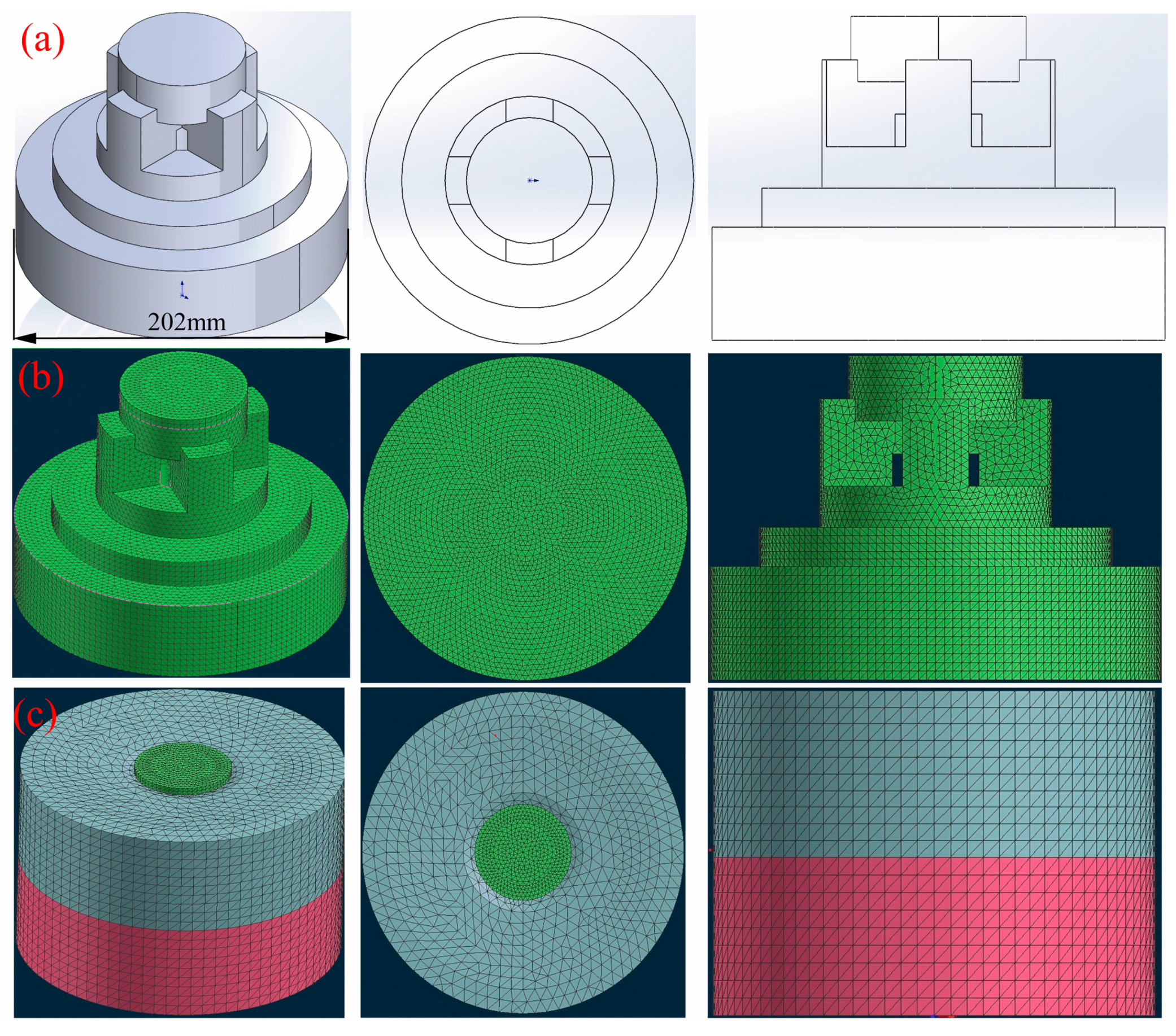


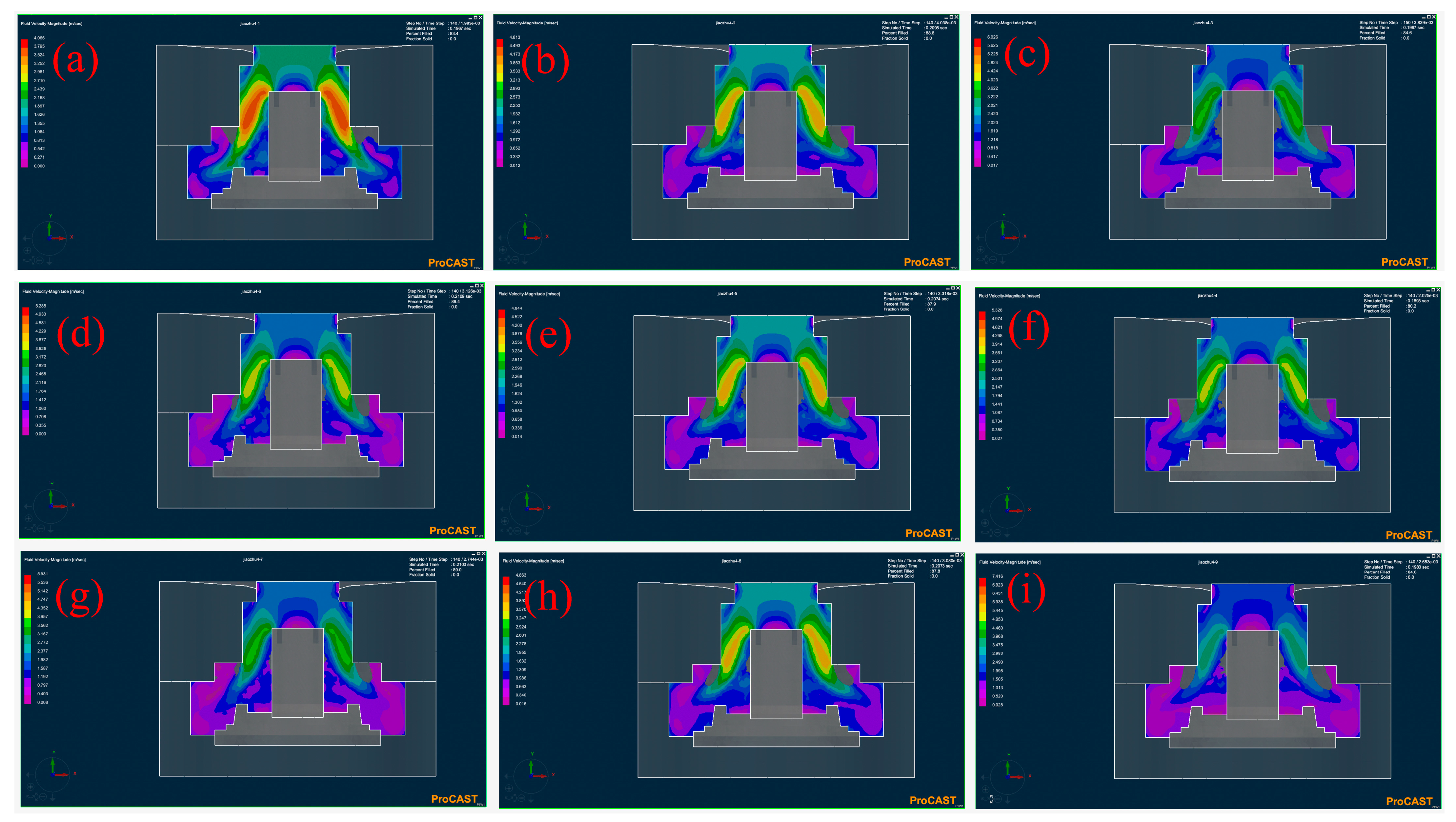
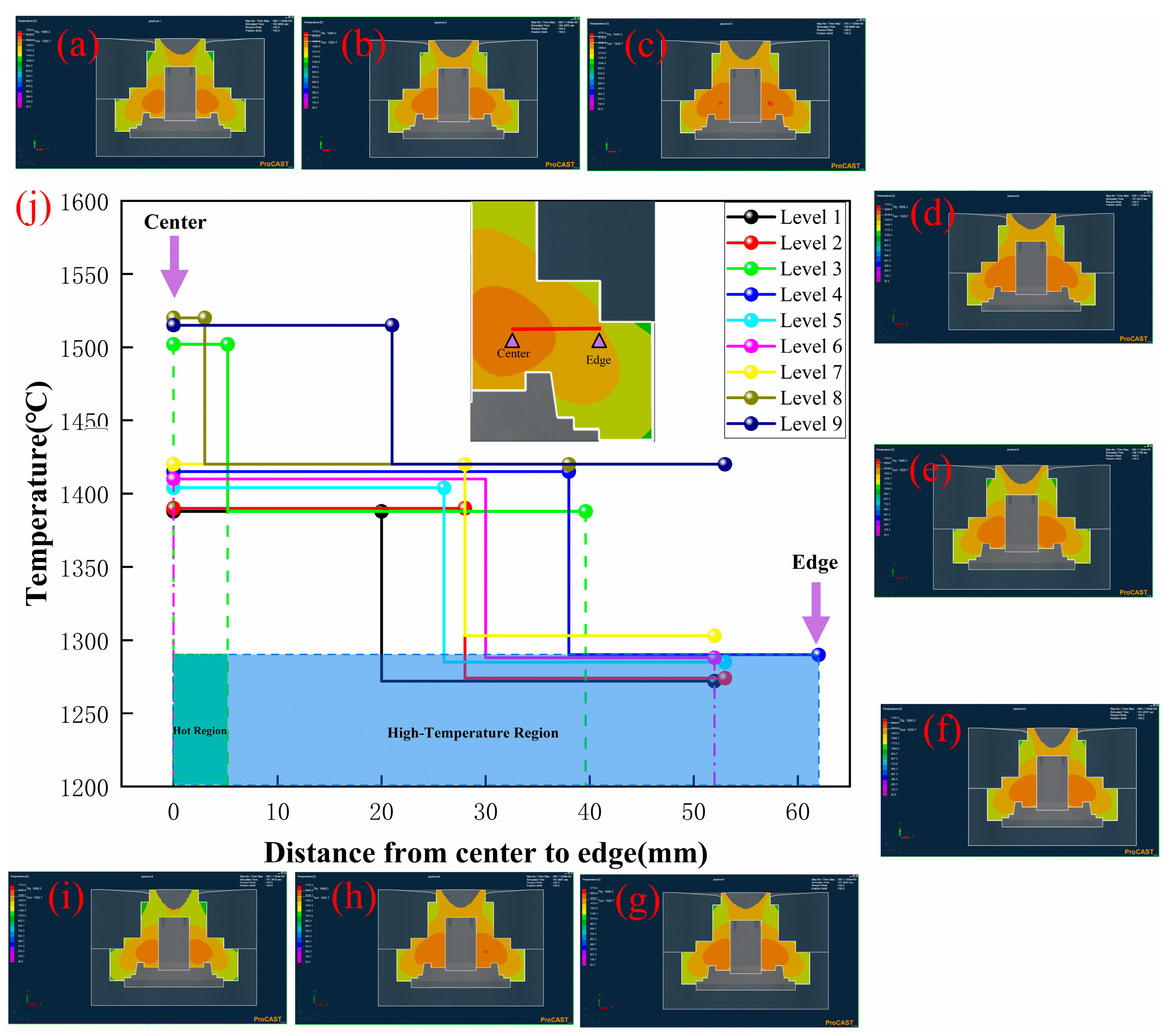
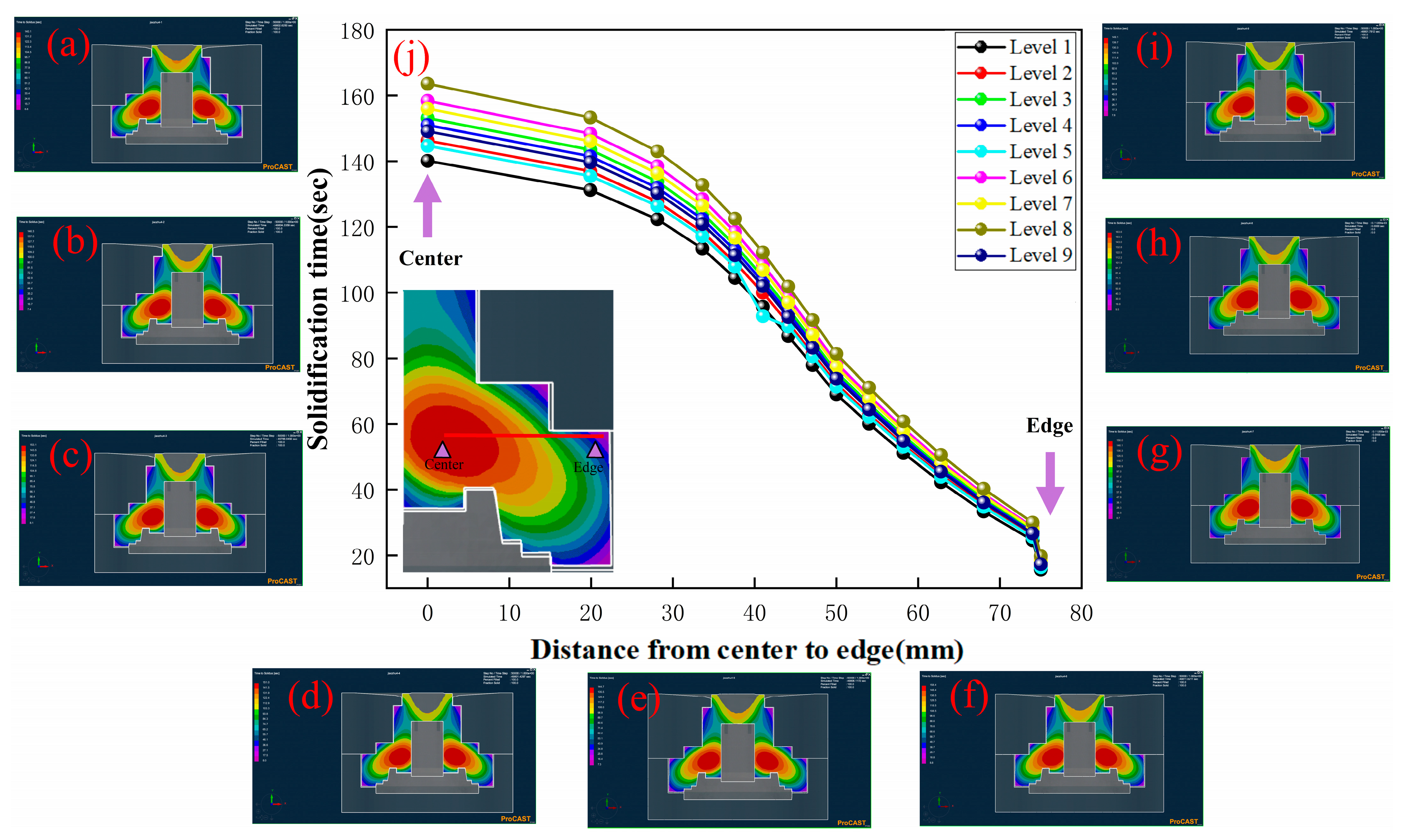
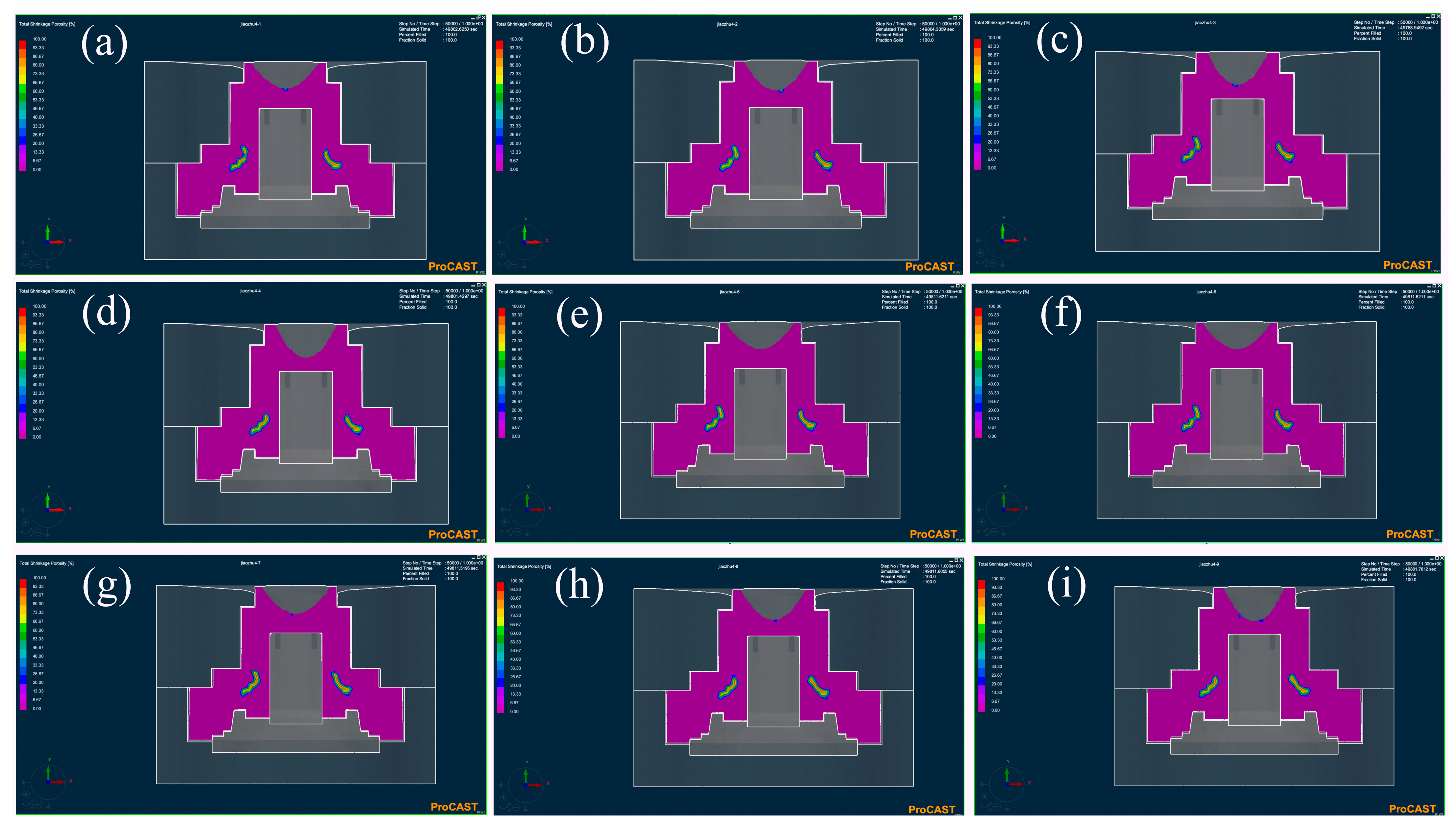
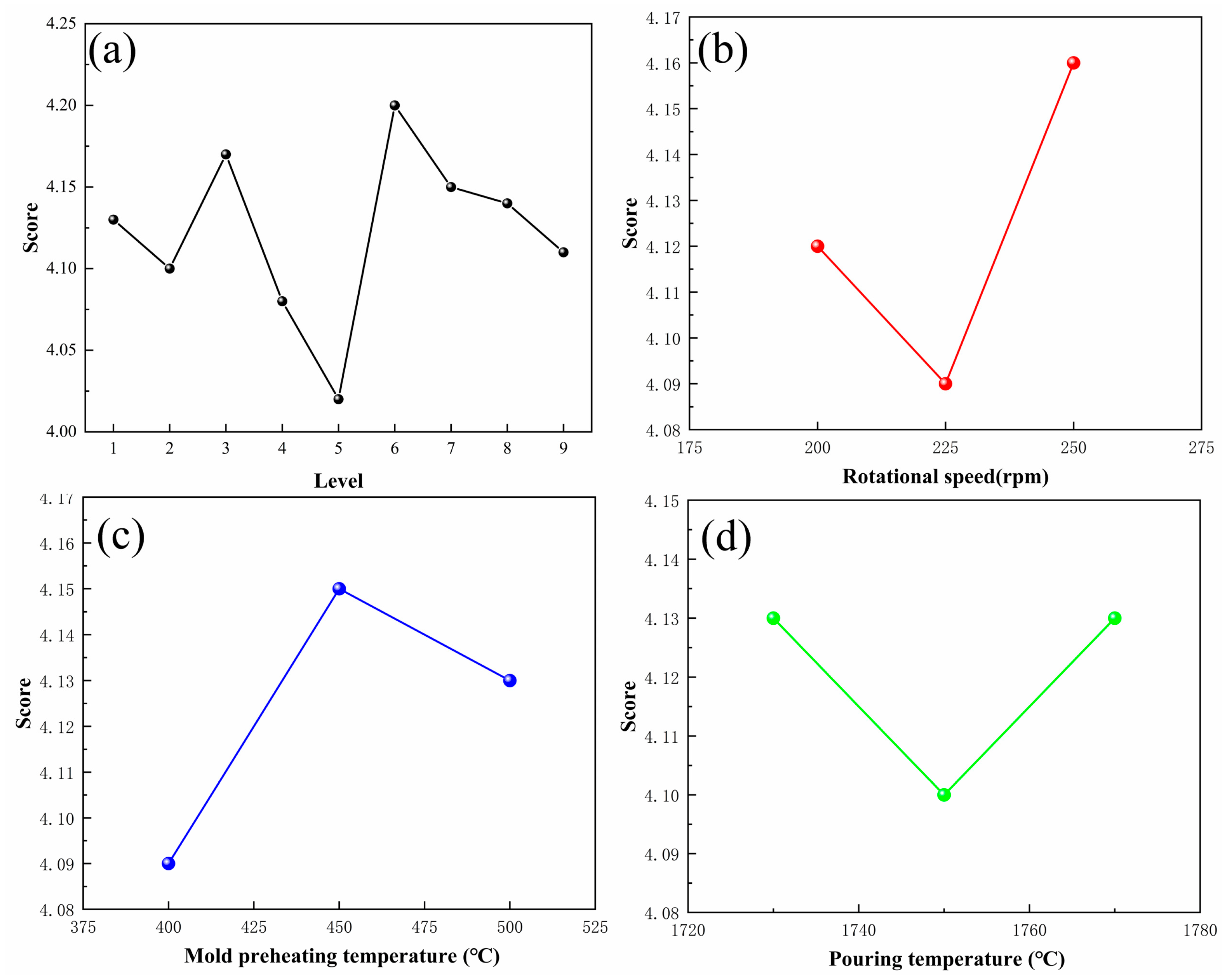


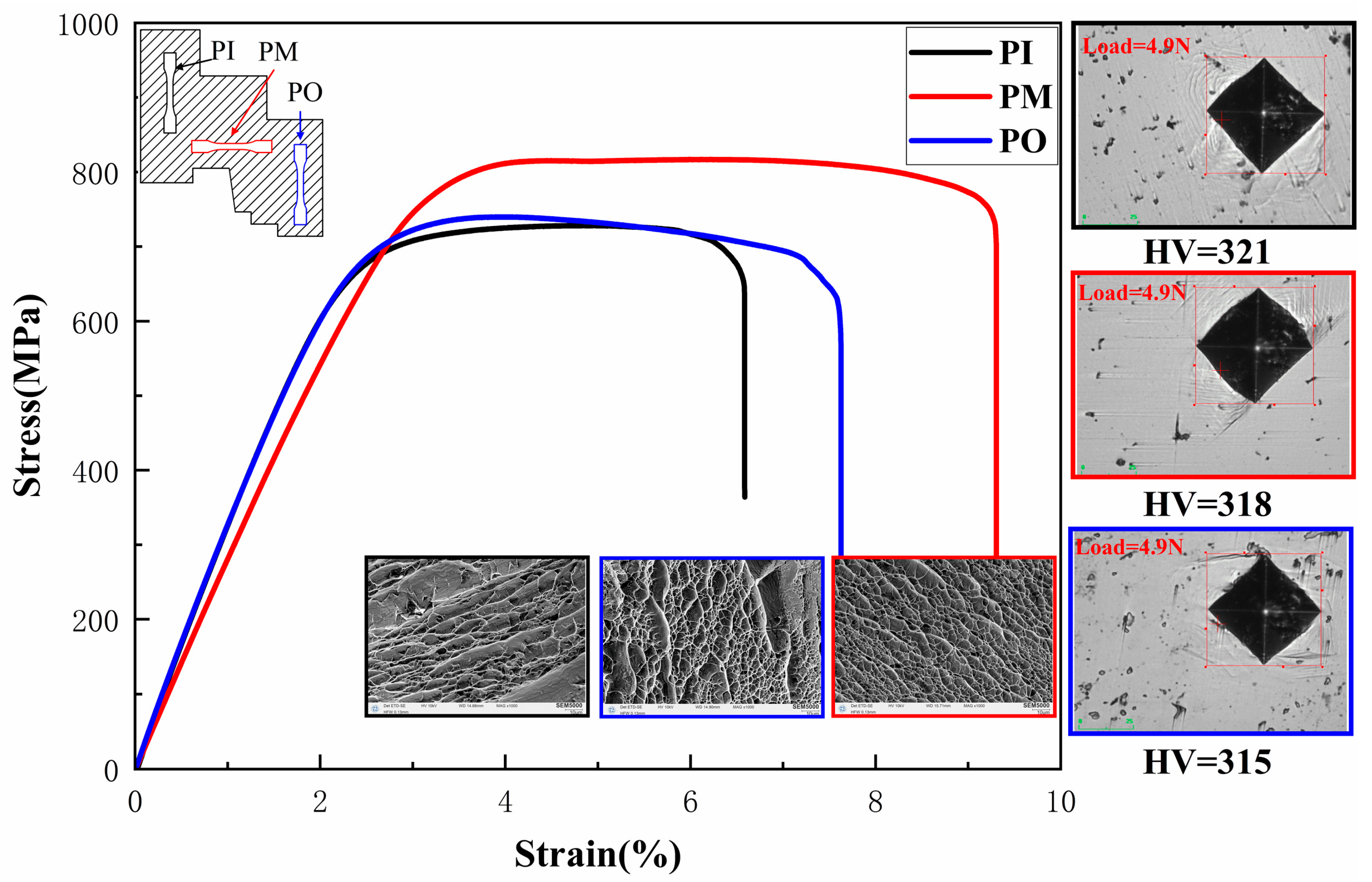
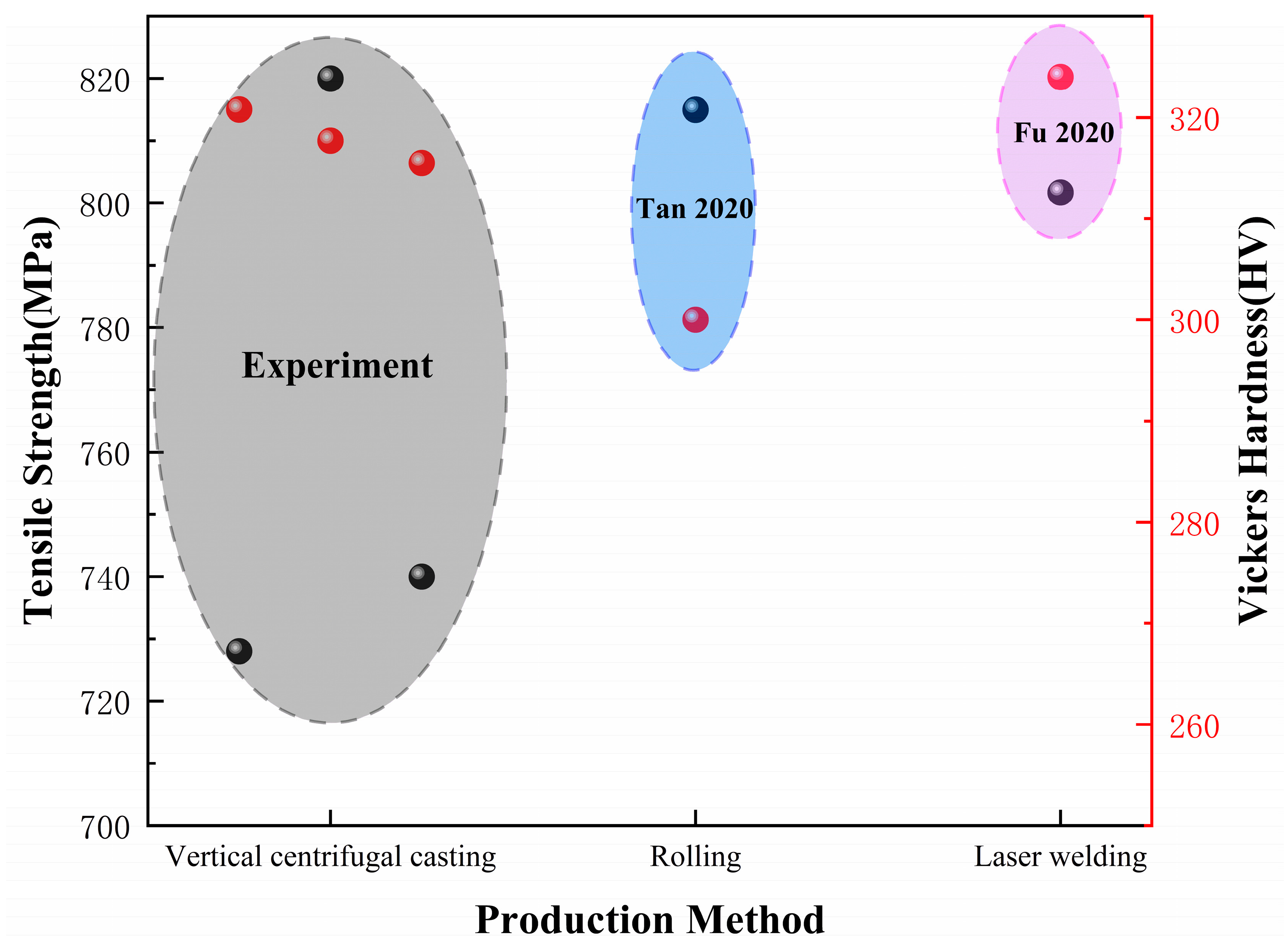
| Level | Rotational Speed (R)/rpm | Mold Preheating Temperature (M)/°C | Pouring Temperature (P)/°C |
|---|---|---|---|
| 1 | 200 | 400 | 1730 |
| 2 | 225 | 450 | 1730 |
| 3 | 250 | 500 | 1730 |
| 4 | 200 | 500 | 1750 |
| 5 | 225 | 400 | 1750 |
| 6 | 250 | 450 | 1750 |
| 7 | 200 | 450 | 1770 |
| 8 | 225 | 500 | 1770 |
| 9 | 250 | 400 | 1770 |
| Simulation Parameters (Unit) | Value |
|---|---|
| The number of 2D elements | 33,224 |
| The number of 3D elements | 397,642 |
| Interfacial heat transfer coefficient of alloy and outer mold (W·m−2·K−1) | 400 |
| Interfacial heat transfer coefficient of alloy and inner mold (W·m−2·K−1) | 300 |
| Mass flow rate (kg/s) | 35 |
| Stop criterion: Final temperature (°C) | 400 |
| Maximum fill fraction | 100% |
| Ti | Al | V | N | O | Fe | H |
|---|---|---|---|---|---|---|
| 89.135 | 6.3 | 4.25 | 0.004 | 0.15 | 0.16 | 0.001 |
| Level | Rotational Speed (R)/rpm | Mold Preheating Temperature (M)/°C | Pouring Temperature (P)/°C | Score |
|---|---|---|---|---|
| 1 | 200 | 400 | 1730 | 4.13 |
| 2 | 225 | 450 | 1730 | 4.10 |
| 3 | 250 | 500 | 1730 | 4.17 |
| 4 | 200 | 500 | 1750 | 4.08 |
| 5 | 225 | 400 | 1750 | 4.02 |
| 6 | 250 | 450 | 1750 | 4.20 |
| 7 | 200 | 450 | 1770 | 4.15 |
| 8 | 225 | 500 | 1770 | 4.14 |
| 9 | 250 | 400 | 1770 | 4.11 |
| K1 | 4.12 | 4.09 | 4.13 | |
| K2 | 4.09 | 4.15 | 4.10 | |
| K3 | 4.16 | 4.13 | 4.13 | |
| r | 0.07 | 0.06 | 0.03 | |
| Order | R > M > P | |||
| Optimization | 225 | 400 | 1750 | |
Disclaimer/Publisher’s Note: The statements, opinions and data contained in all publications are solely those of the individual author(s) and contributor(s) and not of MDPI and/or the editor(s). MDPI and/or the editor(s) disclaim responsibility for any injury to people or property resulting from any ideas, methods, instructions or products referred to in the content. |
© 2023 by the authors. Licensee MDPI, Basel, Switzerland. This article is an open access article distributed under the terms and conditions of the Creative Commons Attribution (CC BY) license (https://creativecommons.org/licenses/by/4.0/).
Share and Cite
Yang, Y.; Wang, X.; Li, X.; Zhou, R.; He, Z.; Jiang, Y. Numerical Simulation on Solidification during Vertical Centrifugal Casting Process for TC4 Alloy Wheel Hub with Enhanced Mechanical Properties. Materials 2024, 17, 184. https://doi.org/10.3390/ma17010184
Yang Y, Wang X, Li X, Zhou R, He Z, Jiang Y. Numerical Simulation on Solidification during Vertical Centrifugal Casting Process for TC4 Alloy Wheel Hub with Enhanced Mechanical Properties. Materials. 2024; 17(1):184. https://doi.org/10.3390/ma17010184
Chicago/Turabian StyleYang, Yujie, Xiangyi Wang, Xiangming Li, Rongfeng Zhou, Zhengyuan He, and Yehua Jiang. 2024. "Numerical Simulation on Solidification during Vertical Centrifugal Casting Process for TC4 Alloy Wheel Hub with Enhanced Mechanical Properties" Materials 17, no. 1: 184. https://doi.org/10.3390/ma17010184
APA StyleYang, Y., Wang, X., Li, X., Zhou, R., He, Z., & Jiang, Y. (2024). Numerical Simulation on Solidification during Vertical Centrifugal Casting Process for TC4 Alloy Wheel Hub with Enhanced Mechanical Properties. Materials, 17(1), 184. https://doi.org/10.3390/ma17010184






